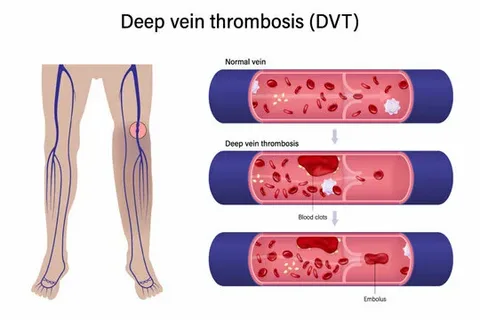What is DVT in medical terms? DVT stands for Deep Vein Thrombosis, a condition where a blood clot (thrombus) forms in a deep vein, most often in the legs.
In medical terms, it is the formation of a clot within the deep venous system of the body. The term “deep” refers to veins located deeper inside the body, as opposed to those near the skin’s surface.
Definition of DVT
DVT is a vascular condition. The word “thrombosis” refers to the formation of a blood clot, and “vein” refers to the blood vessels that carry blood back to the heart. When the clot forms in a deep vein, it can partially or completely block blood flow.
The primary location of DVT is the lower limbs, such as the thigh or calf, but it can also occur in other deep veins in the body.
Learn more about why females have less blood than males here.
Medical Breakdown of the Term “DVT”
Let’s look at each part of the medical term:
| Term | Meaning |
| Deep | Refers to veins located deep within the body |
| Vein | A type of blood vessel that carries blood to the heart |
| Thrombosis | Formation of a clot (thrombus) in the bloodstream |
When these three terms come together, they describe a specific clinical condition that doctors diagnose using imaging and blood tests.
Learn more about the blood group diet chart here.
Why the Medical Term Matters
Medical professionals use specific terms to describe conditions clearly and accurately. Saying “DVT” in a medical setting provides clarity:
- It identifies where the clot is (deep vein)
- It describes what the problem is (thrombosis)
- It separates DVT from other types of clots (like superficial thrombophlebitis)
Knowing what is DVT in medical terms also helps in communication between doctors, nurses, and patients. It reduces confusion and helps guide accurate testing and documentation.
In medicine, every term has a purpose. ‘DVT’ helps doctors quickly define the clot’s location and seriousness.
Learn more about the blood protein levels and cancer here.
DVT vs. Other Medical Terms
Sometimes people confuse DVT with other clot-related terms. Here’s a brief comparison to clarify:
| Term | Meaning |
| DVT | Clot in a deep vein |
| Thrombosis | General term for clot formation |
| Phlebitis | Inflammation of a vein |
| Pulmonary Embolism | A clot that has moved to the lungs from elsewhere |
So when asking what is DVT in medical terms, it’s important to know it specifically refers to deep vein clots and not other types of vascular conditions.
Learn more about how to know your blood type at home here.
Common Use in Clinical Settings
In hospitals and clinics, DVT is a commonly documented term. It is often used in:
- Radiology reports (e.g., “Ultrasound confirms left leg DVT”)
- Discharge summaries (e.g., “Diagnosed with lower limb DVT”)
- Nursing notes (e.g., “Monitoring for signs of DVT”)
The term helps in creating accurate and efficient records in medical environments.
Learn more about what scientists reveal about what to eat according to blood type here.
How DVT Is Coded in Medicine
In medical records and billing, DVT is often referenced with ICD codes (International Classification of Diseases). These codes help track the condition for insurance, reporting, and data collection.
| Code Type | Example | Purpose |
| ICD-10 | I82.4XX (for extremity DVT) | Medical documentation and billing |
| SNOMED | 128053003 | Clinical terminology database |
Using these codes ensures uniformity across hospitals, clinics, and healthcare systems.
Learn more about the 7 reasons your blood sugar can go up here.
How DVT Is Taught in Medical Education
In medical schools, DVT is often introduced early in anatomy and clinical medicine. Students learn:
- The anatomy of deep venous systems
- The definition of thrombosis
- How to recognize terms and abbreviations in charts and textbooks
Understanding what is DVT in medical terms helps future healthcare providers speak a common medical language across specialties.
Every doctor knows DVT by heart—it’s a textbook example of a common vascular term with serious meaning.
Learn more about baby blood sugar levels here.
Summary: What Is DVT in Medical Terms
So, what is DVT in medical terms? It stands for Deep Vein Thrombosis—a clot formed in a deep vein inside the body.
The term is used across healthcare systems to describe a specific type of vascular blockage. It differs from general thrombosis or superficial clots and is often documented using standard medical coding systems.
Understanding what is DVT in medical terms helps patients communicate more effectively with providers and understand their health records with clarity. It is one of the most commonly used abbreviations in vascular medicine.
Learn more about how to prepare chayote for high blood pressure here.
FAQs About What Is DVT in Medical Terms?
What does each part of DVT stand for?
D = Deep, V = Vein, T = Thrombosis. Together, it means a clot in a deep vein.
Is DVT a general term or a specific diagnosis?
It’s a specific medical diagnosis used for blood clots in deep veins.
Is DVT the same as thrombosis?
No. Thrombosis is a general term; DVT refers only to clots in deep veins.
How is DVT documented in medical records?
With terms like “acute DVT” or codes like ICD-10: I82.4XX.
Is DVT used internationally in medical settings?
Yes, it’s recognized globally in hospitals and medical education.
Can DVT occur in places other than the leg?
Yes, though rare, it can occur in other deep veins, but the term still applies.

